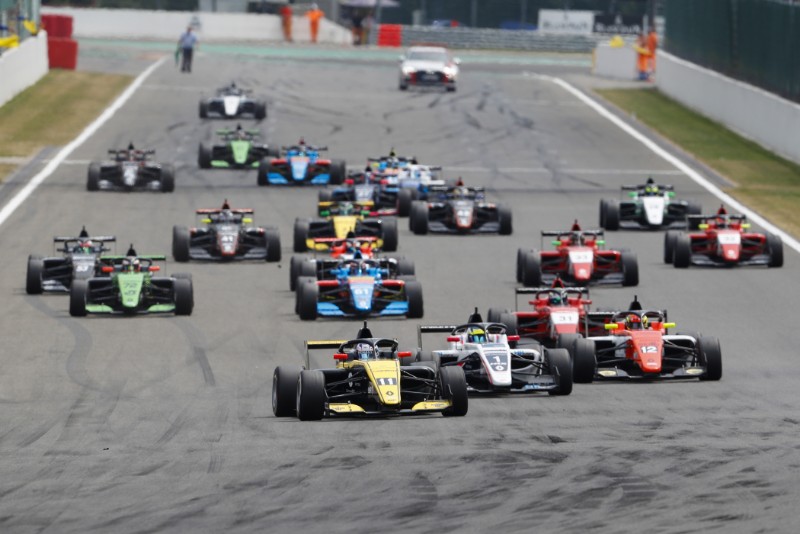
Photo: Renault Sport / DPPI
The FIA World Motor Sport Council has approved several changes to the superlicence system that rewards results in junior single-seaters for drivers intending to race in Formula 1.
Over a three-year period, drivers 18 years old and above need to amass 40 points from a number of eligible championships meeting strict criteria to have an application for an F1 superlicence approved.
FIA Formula 3 Championship’s points tally has increased for its fourth to 10th placed drivers off the back of a super-competitive first season, with the champion still set to receive 30 points.
The Formula Renault Eurocup has been deducted points so it now sits level with newly qualifying championships W Series, Euroformula Open and Japanese F3 (soon to be renamed Super Formula Lights).
Previously, the Eurocup champion earned 18 superlicence points, a tally that has now been decreased to 15. The FIA-supported Regional F3 series in America and Asia have remained on 18, and will be joined by the new-for-2020 Formula Regional Japanese Championship. The Toyota Racing Series, which for 2020 adopts a Regional F3-style car, has had its champion’s tally increased from seven to 10.
The rule requiring championships to have at least 12 starters in every round has been removed. Both the FIA-certified Formula Regional European Championship, which was supposed to award 25 points to the champion, and the Asian F3 Winter Series failed to reach the figure this year.
The ruling on championships with less than 16 classified competitors across the season only earning 75% of the written points [listed in the table below] has also been dropped, with a new ruling taking its place.
“Where fewer than 16 drivers start the first race of a competition in a championship, the number of points awarded to drivers for that championship shall be reduced,” the new ruling states.
“The reduction shall be proportional to the deficit in the number of drivers below the minimum number of 16 and will be calculated incrementally with respect to this deficit on a basis of a 10% reduction per driver below the minimum (e.g. 100% points where 16 or more drivers start, 90% points where 15 drivers start, 80% where 14 drivers start, etc.).
“Where fewer than 16 drivers start the first race of more than one competition in a championship, the competition with the lowest number of drivers starting the first race shall be decisive for the above purposes.”
Free Practice Only superlicence holders can now earn more points through successful FP1 appearances in F1, and drivers can claim points from two junior single-seater series per year if their calendars do not overlap.
The new changes will not effect applications for 2020 superlicences, as the new points are applicable for championships completed in 2020 (barring the defunct GP3 Series).
FIA superlicence points (single-seaters only)
| Championship | 1st | 2nd | 3rd | 4th | 5th | 6th | 7th | 8th | 9th | 10th |
|---|---|---|---|---|---|---|---|---|---|---|
| Formula 2 | 40 | 40 | 40 | 30 | 20 | 10 | 8 | 6 | 4 | 3 |
| IndyCar | 40 | 30 | 20 | 10 | 8 | 6 | 4 | 3 | 2 | 1 |
| FIA F3 | 30 | 25 | 20 | 15 | 12 | 9 | 7 | 5 | 3 | 2 |
| European F3 | 30 | 25 | 20 | 10 | 8 | 6 | 4 | 3 | 2 | 1 |
| Formula E | 30 | 25 | 20 | 10 | 8 | 6 | 4 | 3 | 2 | 1 |
| GP3 (2018) | 25 | 20 | 15 | 10 | 7 | 5 | 3 | 2 | 1 | 0 |
| Formula Regional EU | 25 | 20 | 15 | 10 | 7 | 5 | 3 | 2 | 1 | 0 |
| Super Formula | 25 | 20 | 15 | 10 | 7 | 5 | 3 | 2 | 1 | 0 |
| Regional F3 America, Asia, Japan | 18 | 14 | 12 | 10 | 6 | 4 | 3 | 2 | 1 | 0 |
| Indy Lights | 15 | 12 | 10 | 7 | 5 | 3 | 2 | 1 | 0 | 0 |
| Regional F3 W, Eurocup | 15 | 12 | 10 | 7 | 5 | 3 | 2 | 1 | 0 | 0 |
| EF Open, SF Lights | 15 | 12 | 10 | 7 | 5 | 3 | 2 | 1 | 0 | 0 |
| FIA National F4 | 12 | 10 | 7 | 5 | 3 | 2 | 1 | 0 | 0 | 0 |
| Asian F3 Winter Series | 10 | 7 | 5 | 3 | 1 | 0 | 0 | 0 | 0 | 0 |
| F3 Australia, Britain, CEZ | 10 | 7 | 5 | 3 | 1 | 0 | 0 | 0 | 0 | 0 |
| Indy Pro 2000 | 10 | 7 | 5 | 3 | 1 | 0 | 0 | 0 | 0 | 0 |
| Toyota Racing Series | 10 | 7 | 5 | 3 | 1 | 0 | 0 | 0 | 0 | 0 |
| FIA F3 World Cup | 5 | 0 | 0 | 0 | 0 | 0 | 0 | 0 | 0 | 0 |